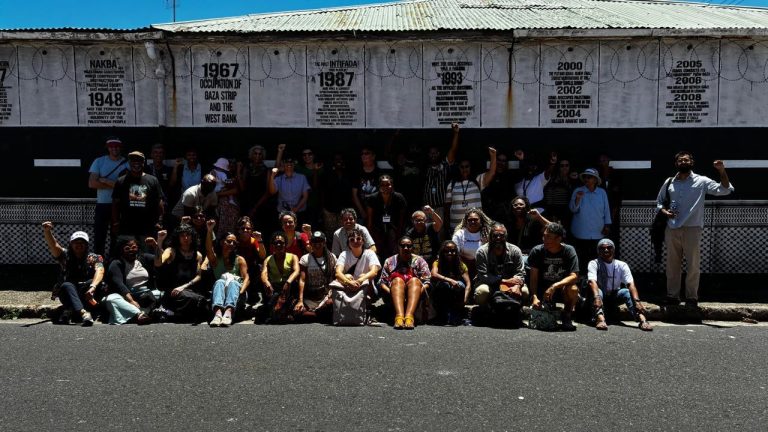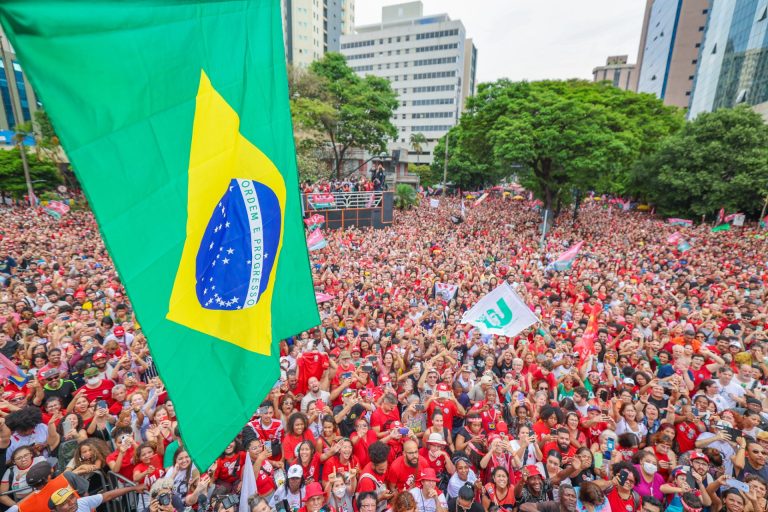This Land Is Our Land
How Brazil’s Landless Workers’ Movement emerged from right-wing rule stronger than ever

By Vincent Bevins
From The Nation
If you went to a trendy restaurant in São Paulo in 2021 or 2022, you were likely to see the red hat. If you went to Mamba Negra, the underground rave with DJs visiting from Berlin, or to enough art gallery openings—in short, if you hung around the country’s progressive cultural elite—you were likely to see the red hat.
The hat in question is a scarlet baseball cap depicting a man and a woman emerging from a green map of Brazil. The man raises a machete high above his head—ready to tend to the crops or, if you prefer, to go to battle. The image has been the logo of Brazil’s Movimento dos Trabalhadores Rurais Sem Terra (MST), known in English as the Landless Workers’ Movement, since shortly after its founding in 1984.
The MST pushes for land redistribution by occupying plots controlled by the country’s traditional elites or by upstart capitalists profiting from an agricultural boom. The group depends on an article in the Brazilian Constitution that mandates that land must fulfill a “social function”; if its members deem that land is unproductive or being misused, they set up camp and fight for legal recognition of their settlements. Over four decades, the MST has become the largest social movement in Latin America and perhaps in the world. It comprises as many as 2 million people across the country and has been a consistent presence on the radical left wing of Brazilian politics.
During the presidency of Jair Bolsonaro, from 2019 to 2023, the popularity of the red hat grew. Nearly everyone in the MST comes from the poor margins of society, and almost all of its activities are rural—and yet the downtown city kids were decked out in its gear. “Nah sis,” one person wrote in a tweet. “That hat is becoming an accessory to wear at the clubs.” The MST Communications Sector replied to the viral post with a press release: “Land reform requires the support of all of society.” The MST was proud to have people wearing its symbols. “But don’t forget!” the statement continued. “We must also be committed to supporting the people’s struggle.”

The hat’s proliferation was, in fact, the result of a carefully laid plan to forge links between the MST and broader forces in society during a dangerous period for the Brazilian left. Bolsonaro’s administration oversaw the rampant destruction of the rainforest, promoted gun ownership in the country, and was explicitly hostile toward the MST. (Bolsonaro’s environmental minister published a pamphlet suggesting that a pack of bullets was the solution to both wild boars and the Landless Workers’ Movement.) During his presidency, the MST chose to slow down its land occupations to protect its members. Meanwhile, it made a tactical alliance with progressive elements of the urban bourgeoisie and used its existing encampments to become a major organic food producer. The strategy worked: By selling radical attire to the rich and helping to feed the poor, the MST gained support in the cities.
There is perhaps no organization with a better reputation among leftists around the world than the MST. Its admirers will tell you that the group has managed accomplishments that elude progressive movements elsewhere: It maintains a radical approach, pushing for revolution in the long term while providing homes and incomes for working-class Brazilians in the short; it has adapted to shifting conditions without suffering major rifts; and it fought to get Luiz Inácio Lula da Silva, Brazil’s once and current president, out of prison in 2019 and back into power, all while keeping its independence from the ruling Workers’ Party. “We have been very inspired by the MST as a political and social movement,” Enzo Camacho, from the ALPAS Pilipinas, a group that works to organize the Filipino diaspora in Berlin, told me. Belén Díaz, a sociologist and a member of the left-feminist Bloque Latinoamericano collective, put it more bluntly: “The Landless Workers’ Movement is the most respected social movement in the world.”
In October 2022, the Workers’ Party won back the keys to the presidential palace and, despite a January 6–like coup attempt by Bolsonaro and his supporters, Lula took up residence the following year. With democracy secured and the reactionaries out of the executive branch, the MST shifted into a more offensive posture: It began to seize more unused land and to occupy illegal farms once again. The movement’s return to its pre-Bolsonaro form seemed to surprise Lula’s administration, and it generated some mainstream attention. In 2023, a New York Times headline read “If You Don’t Use Your Land, These Marxists May Take It.”
Though Bolsonaro was defeated in 2022, his Partido Liberal won the largest bloc of seats in Congress. Lula must work with the right-wing forces funded by rich landowners and rapacious agribusinesses, lest his administration risk impeachment or abuses of the legal system—like the crusades that brought down Dilma Rousseff, the previous left-leaning president, in 2016 and put Lula himself behind bars in 2018. The Bolsonarista movement has also continued to use its power, inside official institutions and on the ground, to target the MST. To deliver for its members in a country of continental proportions, the MST must nimbly weave between these powerful contradictory forces. On the one hand, it is being called on to serve as a model for left-wing organizations around the world. On the other, the forces of national reaction remain bent on its extermination.
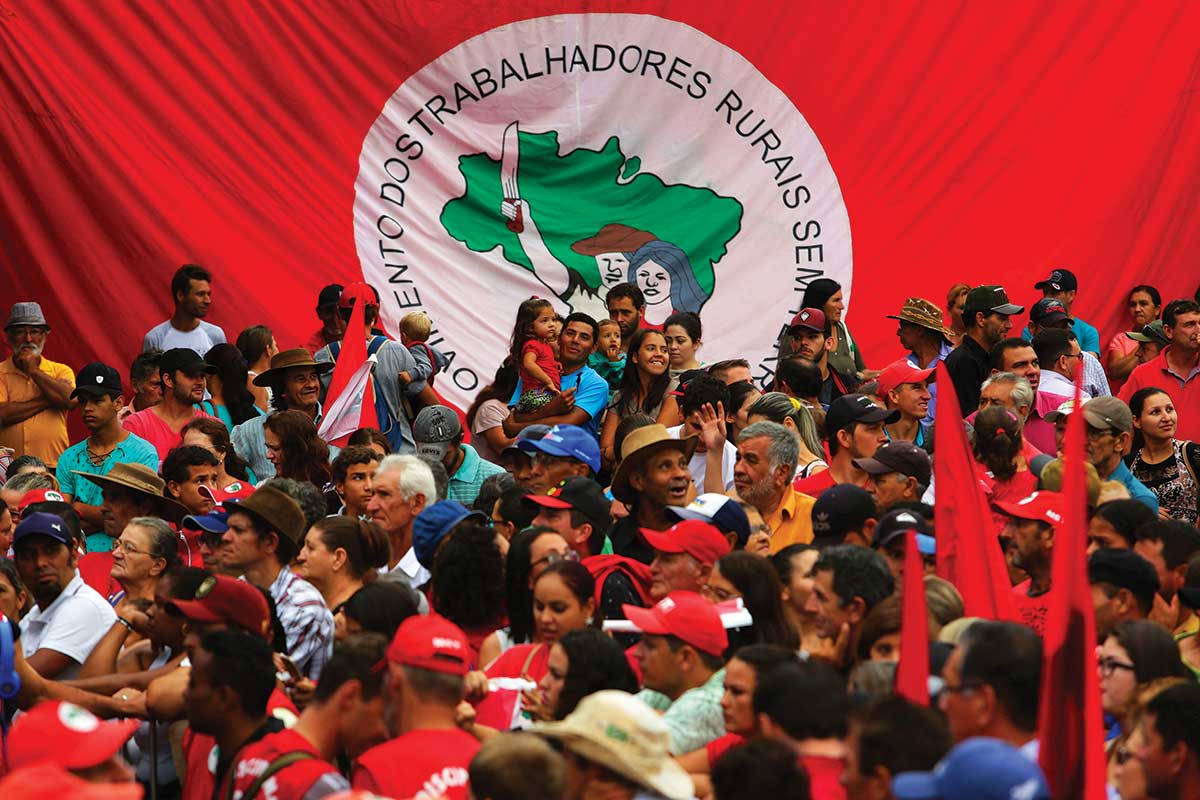
In 2023, the first year of Lula’s current term, I attended the MST’s fourth National Land Reform Fair in São Paulo, held to showcase its members as well as its products. It was the celebration of an organization that had, remarkably, seemed to emerge from the Bolsonaro years even stronger than it had been before them. Gilmar Mauro, a longtime member of the national directorship, told the gathered press to get used to the MST’s return to active pressure. “We have to set aside this idea that there is a good MST and a bad MST, or that the MST of the past is not the MST of the present,” Mauro said. “If you like our food, if you like our organic rice and our butter and our outreach to the hungry in the cities, then you have to understand that everything we have has come through occupation.”
Mauro and I met later at the offices of the National Secretariat in São Paulo, next door to the shop where the MST sells stacks of its red hats. We sat across a big wooden table, surrounded by a small library of books in Portuguese, Spanish, and English. It’s not only Mauro’s dark red tan, cut off by the sleeves of a faded blue button-up, that gives him away as a farmer. He speaks with the rounded twang that’s common in Brazil’s agricultural interior. He is from a family of landless farmers, and he rose through the movement over decades to become one of its public-facing leaders. Academics in the United States or Europe who read a lot of Antonio Gramsci might call Mauro an “organic intellectual,” someone from the class whose interests he defends. Members of the MST might call him that, too, because they also read a lot of Gramsci in their political education programs.
While precise figures are difficult to come by, there are hundreds of thousands of families in the MST. Some live on legalized farms (assentamentos, or settlements) or on occupied land (acampamentos, or encampments) that’s awaiting recognition from the land-reform authorities, and some are full-time militantes (activists or militants, as you prefer). Spread across a country twice the size of the European Union, they hammer out decisions in group chats and at periodic meetings that require long bus trips. Mauro attributes the resilience of the movement to its organizational structure. A given “political line” is arrived at democratically, and once a decision is made, everyone adopts it, even those who never liked the idea. Paraphrasing the Marxist theorist Rosa Luxemburg, Mauro explained, “It is much better for all of us to discuss, plan, and make a mistake collectively than for each of us to do the right thing as individuals.”
It was nearly sunset, but Mauro drank an alarming amount of black coffee as we talked. On the wall to his left was a picture of the Mexican revolutionary Emiliano Zapata, and to the right, a photo of the MST marching against Lula’s imprisonment in 2018. Outside, a large photo of the Indigenous rights defender Bruno Pereira and my friend Dom Phillips, a British journalist, hung on a wall. They were murdered while working together in the Amazon in 2022, as retribution for Pereira’s work defending tribes from illegal land invasions. It is the kind of violence that stalks the MST, too.
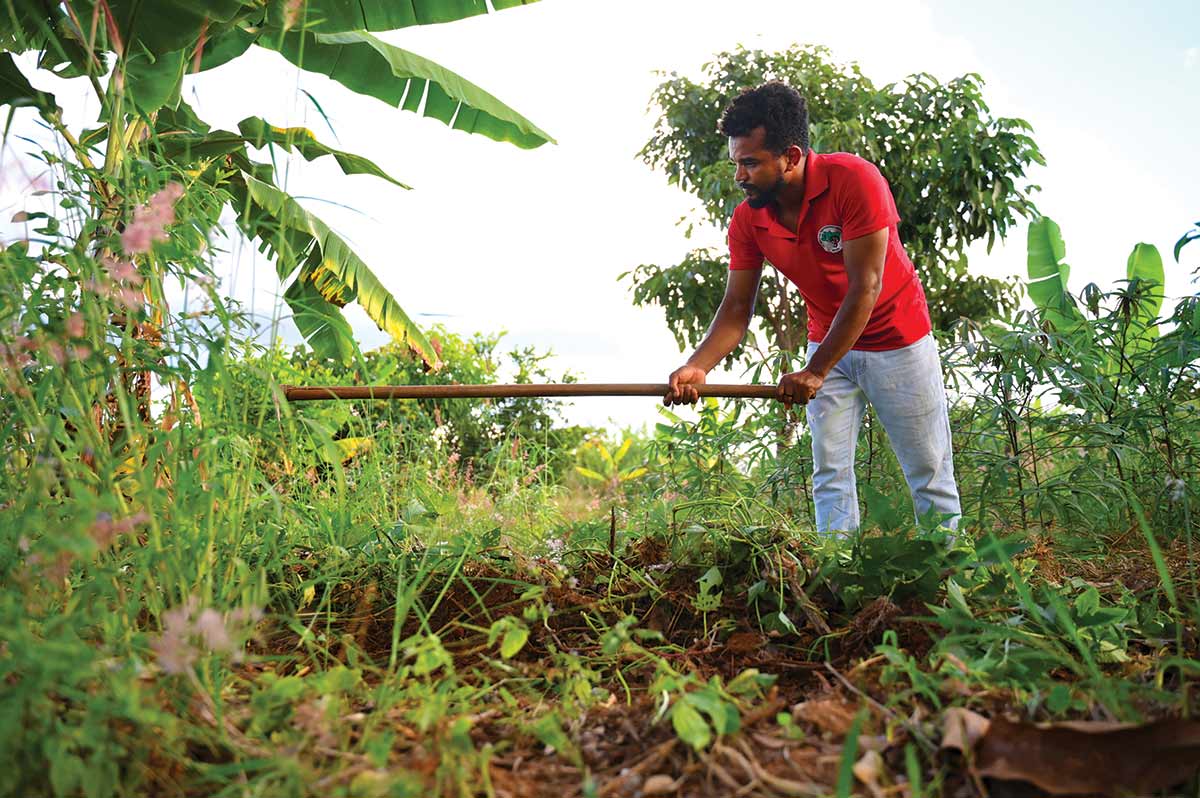
Jocelda Ivone de Oliveira, 42, does her best to keep up with national and geopolitical developments. She lives in the state of Paraná, on one of the movement’s encampments, and follows MST debates on her phone. Sometimes she heads into the local capital, Curitiba, for a meeting. But most of her time is devoted to day-to-day matters at home, deep in Brazil’s agricultural heartland. De Oliveira is on the coordination directorship of her encampment, where more than 1,000 people live on and work the land.
It took me a few hours to get to the site from the nearest city. I had to swerve and tumble on red-dirt streets between tall eucalyptus trees. But the horizon opened after I entered the encampment and made my way down to a little village, where a few dozen small buildings clustered around an intersection. The locals shuffled me into the green shack they had built for visitors—I would be staying there with some teachers—and then de Oliveira came to take me to the school.
“Every day I wake up, make breakfast, take care of my family, and we tend to the encampment,” she told me. “But every day I am worried that we will be forced off this land, that the government will kick us out, and once more we won’t know what to make of our future.”
De Oliveira and I walked up a hill to the encampment’s schoolhouse; it’s now part of the national public education system, which gives it access to state resources. On that day, government officials from the local school district were visiting, and militantes working in MST’s Education Sector served them cake and sweet coffee as they inspected the new PCs in the computer lab. Down the street, the little Mercado Che Guevara, featuring a painting of the Argentine revolutionary, was about to close, and the bar across the road was about to open. At both, you could buy locally produced food, or you could buy mass-produced products brought in from the city.
The encampments have a complex organizational structure. Ideally, responsibilities are assigned based on ability. The Discipline Sector enforces the rules; domestic violence and child abuse, for example, lead to automatic expulsion. Drug use is prohibited, mostly to protect the encampments against accusations of trafficking or criminal activities. The MST requires at least 50 percent women in its national directorship, but in the encampments, the percentage is often higher.
The MST also assigns political tasks. Lula was held in jail in Curitiba, and during each of his 580 days behind bars, the MST sent members to stand in front of the prison, demanding that he be freed. (In 2021, the Supreme Court threw out the corruption charges against him.) During the vigil, the MST set up on-site ideological training, and psychiatrists offered free therapy to the militants and families camped out there.
Many MST members jump at the chance to head to the city for movement activities. Others, used to the quiet life, drag their feet. But the encampment is structured collectively, and some tasks are not optional. “Technically, no one is required to do anything,” a high school geography teacher named Roberto Soares joked as his students polished off a free after-school dinner of chicken and polenta. “Just like no one is required to live on an encampment as part of the MST.”
Even though the group has been here a long time and has formed deep connections with the local community, de Oliveira has reason to worry. Paraná is a major outpost of Bolsonarismo. It is not just that private agribusiness is strong here and that voters are conservative. Paraná was the center of the US-backed and now-discredited anti-corruption crusade that dogged the Workers’ Party for years. The judge who sent Lula to prison, whom the Supreme Court ruled failed to act impartially, immediately joined Bolsonaro’s government in 2019; now he is a senator representing the state. Surviving here has required a delicate, cautious dance around reactionary forces. “What did Bolsonaro want?” de Oliveira asked as we sat near her house one evening. “He wanted a provocation, so he could use it as justification to massacre us. We could not beat him in direct confrontation. So we did the opposite, and we focused on what we do best: producing food.”
This strategy proved crucial during the pandemic, when, despite the agricultural boom that now powers so much of the country’s GDP, thousands of Brazilians began to starve. In response, the MST shipped 7,000 tons of food for distribution in the cities. On this encampment, each family produces subsistence crops—cassava, pumpkin, rice, and beans, for example, alongside a wide selection of fruits and some livestock. But they also cultivate a plot of land for cash crops. With that income, they buy tractors, cars, cell phone plans, and cool sunglasses.
Miriam Barino, a soft-spoken middle-aged woman, oversees the encampment’s subsistence farming. She has children who work at jobs in the city, and her next-door neighbor, Marilda Silva Pereira, has a daughter who works as a chemist in Germany. “I used to be a tenant farmer, but now I don’t have to pay any rent to any landlords,” Barino told me as two residents tended the soil next to her under the low winter sun. She supervises a complicated arrangement of allotments, mapped out in ink on a weathered piece of paper she showed me in her kitchen. “The way we see it, most people living in the favelas in the cities were kicked off the land when big farmers replaced them with machines,” she told me. “Their place is here.”
Sometimes the MST’s occupations turn into settlements quickly; sometimes they take decades; and sometimes they are judged illegal or dispersed by force. This one in Paraná should work out eventually, if the land-reform authorities can arrive at a suitable government payment to the landowners. But even though the MST moved onto the land 20 years ago, de Oliveira, Barino, and the others remain occupiers, not permanent residents. There is a group on guard at the only entrance from the nearest highway. The day I arrived at the encampment, I had to identify myself to make it past the five or six people who were sitting there watching the barrier as their big red flag, with the same logo as the hat, flew overhead.
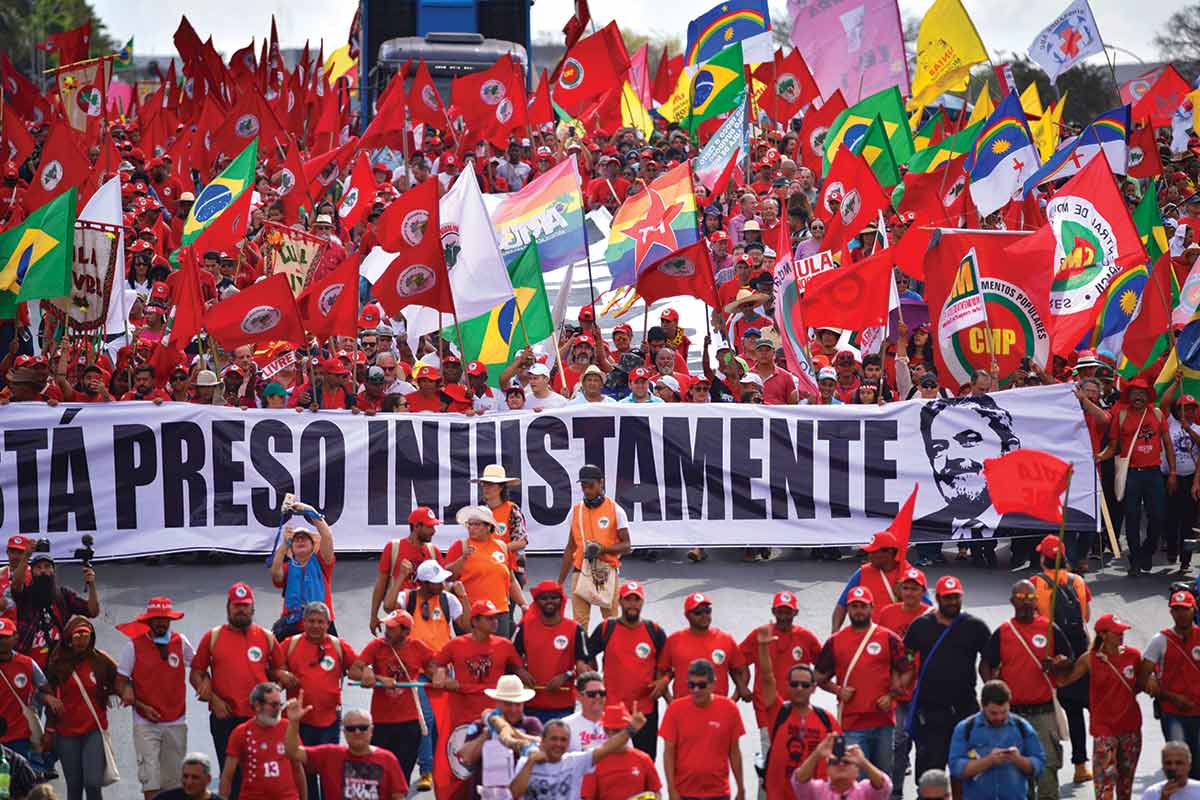
The MST traces its roots to two different movements in Brazilian history. The Ligas Camponesas—or Peasant Leagues, organized by the Brazilian Communist Party in the 1950s—are its most obvious antecedent. After the US-backed coup in 1964, the military dictatorship crushed the Leagues, made up of sharecroppers and other landless workers. The movement also traces its history to parts of the Catholic Church inspired by liberation theology; many of its oldest members have some connection to the Comissão Pastoral da Terra, a rural church group born during the dictatorship. (This dual lineage, to both priests and Marxists, is not uncommon in Brazil: Progressive Catholic factions and former guerrillas made up the early ranks of Lula’s Workers’ Party.)
But in its books and its cadre-formation programs, the MST places itself within a much longer story, one that reaches back to ancient Rome and winds through European feudalism. It sees Brazil’s land struggles as foundational: The country was born as a colony that exported agricultural products, with land awarded to aristocrats in the Portuguese system and kept productive by Indigenous and enslaved people. Hundreds of years later, as the MST sees it, that system remains more or less intact—except that many of the descendants of those workers have been thrown off the land and forced into the poverty and dangers of urban life.
In this account, there are a series of missed opportunities. After the abolition of slavery in 1888, the monarchy provided no reparations to the people who had been working on the farms, and the country never enacted land reform. The MST points to the land distribution programs under President Abraham Lincoln as part of the reason the United States jumped ahead of Latin America—with some major caveats, including the United States’ neglect of formerly enslaved communities and its destruction of Indigenous nations (the movement fiercely defends the recognition of Brazilian tribal lands). Then, in the 20th century, Brazil’s bourgeoisie proved too weak to effectively push for the land reform that would have allowed the country to industrialize. Brazil’s natural resources remained in the hands of a tiny, predatory elite, which was both ruthlessly extractivist and stupidly inefficient.
As a result, Brazil slid into underdevelopment; MST literature emphasizes that it was precisely the push for land reform, by the left-leaning president João “Jango” Goulart, that led the rich to unite behind the US-backed coup in 1964. The military government that followed came up with a plan to distribute small plots to Brazilian families, but powerful landowners blocked its implementation.
Starting in the early 1980s, as the country began moving toward democracy, landless workers began agitating for plots to be awarded to them, especially in the South. Their method was occupation, and they coalesced into the MST in January 1984. In 1988, the new Constitution specified that land could, under the right conditions, be handed over to families. Much of the legality and legitimacy of the MST’s activities hinge on the wording of Article 186, which establishes the minimum requirements for private landowners: They must “make rational and adequate use” of the land and “preserve the natural environment,” while complying with all rural and labor regulations; and the state must pay them if their holdings are taken away. But just as with protections for the Amazon and for Indigenous people, these promises collided with private economic power. In the absence of additional pressure, officials at the National Land Reform Institute never seemed to do anything. For the MST, the solution was occupation.
During Lula’s first two terms, from 2003 to 2010, the economy surged, thanks in part to commodity exports to China, only to slow as prices dropped and the country was consumed by political crises between 2015 and 2018: Dilma Rousseff was replaced by Michel Temer, the unelected pro-business president; Lula was imprisoned; and by the time Bolsonaro ran in 2018, the good times were long gone for lower-middle-class Brazilians. With Bolsonaro’s victory, the wealthy landowners gained a full-throated supporter in the presidential palace. João Pedro Stédile, long the MST’s most prominent intellectual, was surprised at just how few people—other than the MST—came out to defend the Workers’ Party when Lula was imprisoned. “There was a lack of popular support,” Stédile told me, “because the workers had already been defeated as a class.”
Paulo Teixeira, Lula’s minister for agrarian development, has been given the task of dealing with both pressure from the left and attacks from the right. “This government listens to social movements, and we filter,” Teixeira told me late one night, as he prepared for a meeting with land-reform authorities in the capital. He believes that the MST’s occupations are a legitimate form of pressure, but he also doesn’t think they’re necessary now that his ministry is pushing forward with land reform—focusing on distributing public lands and the land of owners in debt to the state.
There were at least three instances in 2023 in which the MST had gone too far, Teixeira said—including its occupations of lands owned by a paper and cellulose company and a state-run agricultural research corporation. If the movement occupies land that, it turns out, is being used legally, then the courts will not recognize the settlement and will order the encampment to disperse. Sometimes the wrong target is chosen, and the MST moves on. But the occupations of a productive company and of state facilities were more of an intentional “protest,” Teixeira explained, though he said he wished the MST could have made its point a different way. “Everything that has been done, all the land reform that has been carried out, has taken place within existing legislation and within the Constitution.”
After Lula’s first two terms as president, as the Workers’ Party’s popularity began to wane, some activists (and members) thought the MST had gotten too close to the government and publicly left the group. In the dark years of far-right extremism, however, many came to appreciate the MST’s structure, pragmatism, and institutional links. Now that Lula is back, MST leaders complain that well-meaning leftists (including those in government) tell them that occupations are no longer necessary, or that the group’s intense focus on radical land reform is less relevant in an urbanizing country, or that it must find a way to live alongside major agribusiness rather than try to replace it.
The MST, of course, does not agree. Its Frente de Massas, or Mass Front, sector engages in constant outreach to recruit working-class Brazilians. A few hours from Brasília, in the conservative state of Goiás, a well-known local recruiter known as Frangão, or “Big Chicken,” had been part of the campaign to do exactly that. By asking around in the community, he helped find dozens of people interested in obtaining their own piece of land, assembling a cadre of would-be revolutionaries. I met the women in this group on the poor outskirts of the state capital, Goiânia.
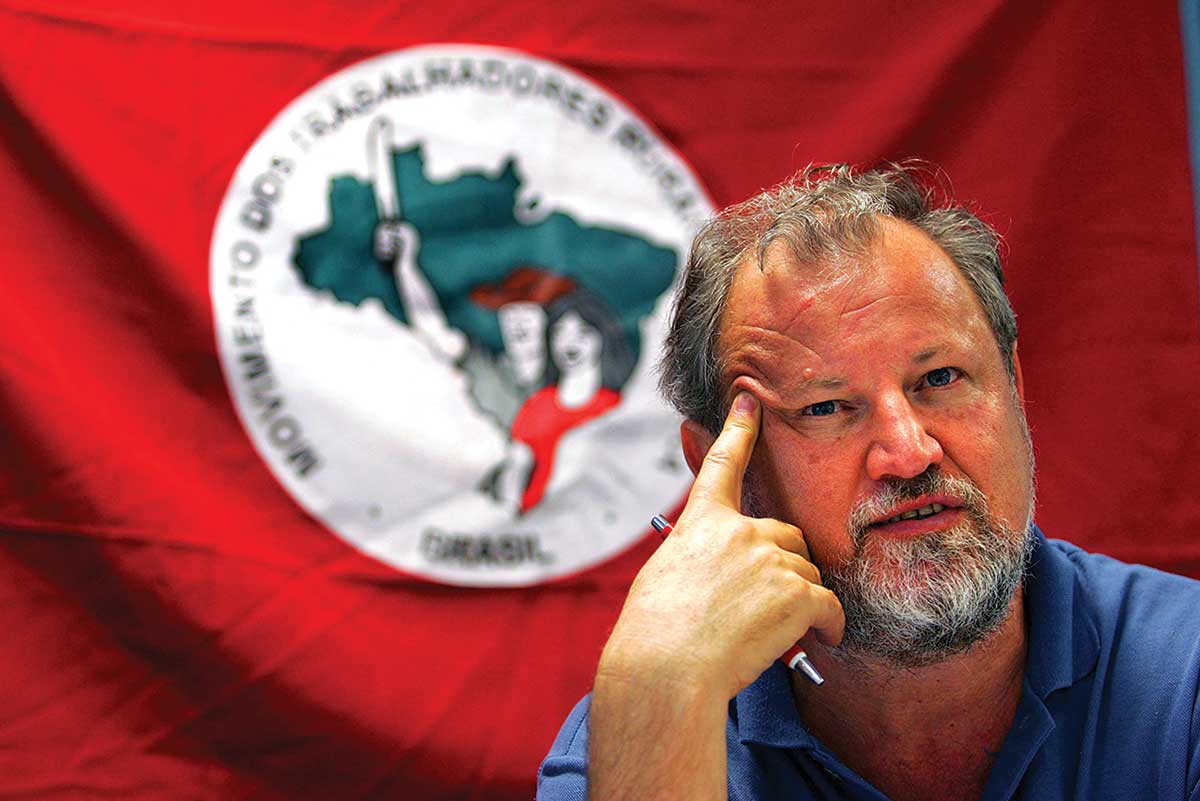
One morning in March 2023, they woke up very early and, joining a group that consisted of approximately 600 families, set out to occupy a large farm outside Goiânia. Packing into cars and vans, they made their way onto the property and hoisted the MST flag on a pole made of sugarcane. They came prepared for months, if not years, of encampment.
Marlene Pereira de Morães, 65, one of the new recruits, told me that she had hoped that the rest of her family could join her on a successful encampment. They figured they had a pretty good chance with the property, since its owner had been convicted of trafficking women for the sex trade. But the state governor had other ideas: He had promised in his campaign that there would be no new “invasions” of private farmland. He sent in the military police and used state forces to intimidate many of the families into staying away. Ueber Alves, an MST lawyer, told me that this tactic is illegal. But when a governor breaks this kind of law, it’s not clear who is supposed to hold him to account.
De Morães and four other recent MST recruits sat with me as they waited in judicial limbo to find out whether they would be able to set up their encampment. Some had farming experience, and some did not; all of them had been busy learning about the MST’s philosophy. “I threw myself into the movement, body and soul,” Avelice Pereira de Sousa told me. “We want to win a piece of land, and we want a place to grow and produce and grow old. And our larger goal, of course, is land reform across the nation.” Francisca Rocha Costa, 68, asked me, very politely, whether they could also record the interview themselves. Someone had warned them that unscrupulous journalists might twist their words.
On my last day at her encampment in Paraná, de Oliveira was whiling away the afternoon with her daughter Heloisa as they chopped up a pig. As often happens, the conversation turned to the history of land reform. “It’s clear that Mao only finally triumphed in the civil war because he had the support of the peasants, the backing of the people, against the big landowners,” she said. Her neighbor Edna Santos, the director of the on-site Education Sector—meaning she oversees the schools the MST has built and integrated into the publicly funded national system—joined in, trying to recall a particular word. “What was it that they called the type of servitude they had in Russia?” she asked. “Serfs. Yes, they lived under serfdom, while in China it was different. They were simply very poor peasants.”
Santos, 55, likes to wear a military cap with the Cuban flag—another one that the MST sells in shops in the cities. She came to the encampment in 2019, after a failed attempt to gain recognition for a settlement that was named after the famous Quilombo dos Palmares, a community in colonial Brazil formed by escaped enslaved Africans. In addition to helping run the school, she serves as DJ at the encampment’s Saturday-night dance parties. “At first I play gaucho music, but as the night goes on, we switch to harder electronic music,” she told me. The concert is held in the “big tent,” more of a hangar, from whose roof hang several giant red MST flags and one rainbow flag that reads “Toda forma de amor é valida”: All love is valid. “I put that one up,” she told me proudly.
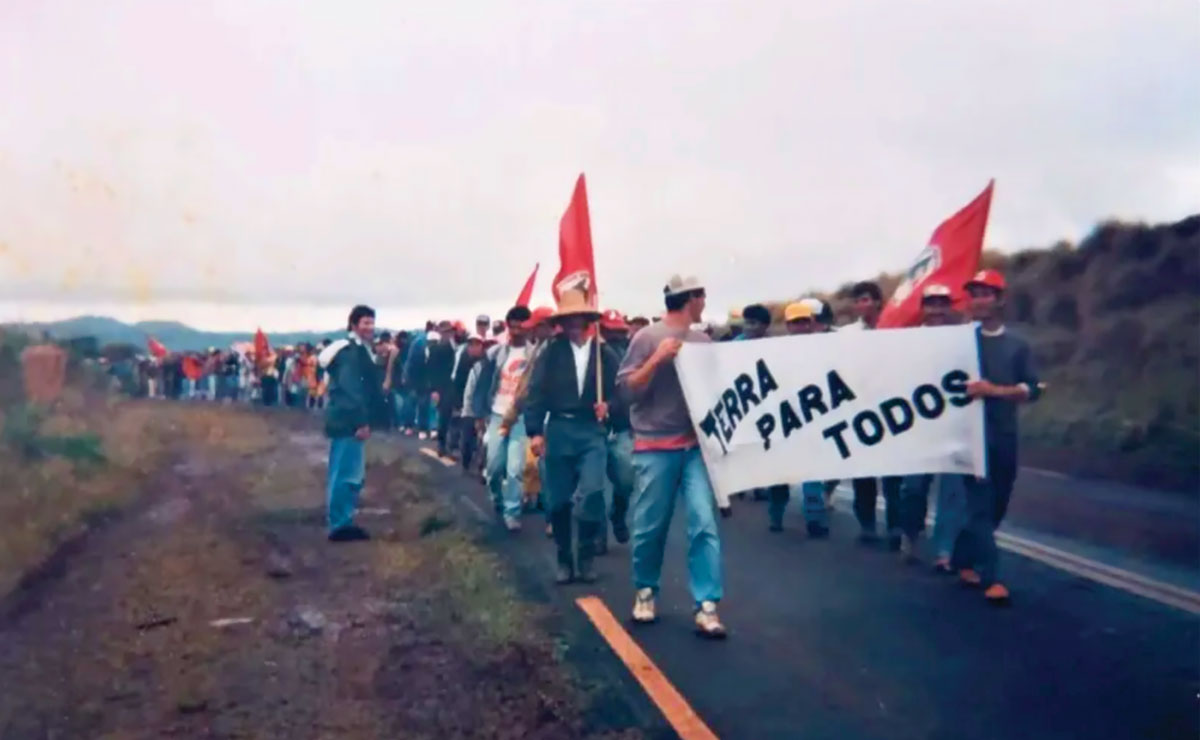
Interest in the revolutionary mission varies widely across the movement. There are people who care mainly about getting their own plot of land and some peace from the violence of the city. The MST has a program to teach members to read and write, modeled on one developed in Cuba, but it is easy to find members who haven’t gone through it and just want to farm. On the other hand, anyone who shows particular interests or a particular set of skills is likely to be nominated for a leadership position or provided with opportunities for further education. They may get a scholarship to pursue an advanced degree in agronomy or in teaching, studying part-time at a major university nearby. “If it weren’t for the way that it had revolutionized education, if not for the way that it also occupied the formal education system, the MST would not still exist in the way that it does today,” said Rebecca Tarlau, a professor at Penn State who has written about the MST’s pedagogy. “Back in 1998 or so, there was not a single leader, except for maybe João Pedro Stédile, that had a college degree.”
After a seven-hour drive back across Paraná toward the Atlantic coast, I met Sara da Lila Wandenberg dos Santos, the 37-year-old coordinator of a smaller encampment. She received a degree in pedagogy from the nearby state university, paid for by the MST, and then traveled to São Paulo to attend the Escola Nacional Florestán Fernandes, the most important of the MST’s political education schools in the country. There she took the Latininho, a short course on the history of social movements offered for activists from all around Latin America. “They spoke in Spanish, and all the Brazilians could basically understand. The other way around would not have worked,” dos Santos said with a laugh.
While de Oliveira’s encampment is in the flat and brown middle of the state, dos Santos’s smaller settlement is located in what is left of the thick, misty Atlantic rainforest. As you cross this state, in the relatively developed part of southeastern Brazil, you can drive on highways and stop at upscale burger joints at rest areas that are reminiscent of contemporary Arizona, or you can take a turn down a long road and find something closer to the American West 150 years ago—a boomtown powered by illegal land grabs and whose laws are enforced by cowboys and hired guns. Dos Santos was looking intently through her black-framed glasses as we talked in her apartment, waiting for her daughter to come home from school and her son to return from table-tennis practice. If she wants to move up in the MST, it probably helps that her encampment won an award for its innovative efforts to recover the local ecosystem.
“In reality, the process of formation begins the moment that people set up an encampment,” said Geraldo Gasparin, one of the two members overseeing the MST’s national political education program. “You learn an incredible amount simply by doing. All of the old generation have got white beards,” he added. “Our job is to train a new generation of militantes.”
The day I paid a visit to the political education school in São Paulo, a group of MST cadres from all around the country had just finished a course on woman thinkers—brasileiras like Nise da Silveira, Vânia Bambirra, and Lélia Gonzalez, who deserve a place in the canon alongside Brazilian men. I confessed to Ruth Teresa Rodrigues dos Santos, a coordinator at the MST warehouse in Rio de Janeiro, that I hadn’t heard of all the names before. “Neither had I,” she replied. “That’s one of the things we intend to change.”
After Lula returned to power, the Bolsonarista right did not wait long to launch a counterattack. Some of its leading politicians quickly opened a parliamentary inquiry into crimes allegedly committed by the MST. For months, it provided a stage for right-wing members of Congress to denounce the social movement.
The commission heard from farmers complaining about their land being taken over and the endless ensuing legal battles. A member of one of these farmers’ families that I spoke with referred to the United States and then immediately asked me not to attribute the quote to him. “This kind of thing would never happen in your country, because you respect the rule of law,” he said. “And you have a law of your own for people who cross the line—how does it go? ‘Go ahead, make my day.’”
I noticed similar comparisons to vigilante justice in the United States throughout my reporting. Waiting to meet with Luciano Lorenzini Zucco, the commission’s president, I sat in the congressman’s office next to a camouflage tactical backpack decorated with the US flag and a Punisher patch, the skull logo often worn by US troops and police. “The right to property is respected in the United States,” Zucco told me once he arrived. “The laws are rigorous and applied if they are broken. Farmers are valued. That’s why we see the US as a model.”
By the end of 2023, the parliamentary inquiry had fizzled out without even producing a final report. But throughout 2024, it had become increasingly clear that the MST was also limited by institutional forces on the left. Though Lula’s government always signals that it is on the side of land reform, the recognition of new settlements has come slower than the MST’s farmers would like. The movement’s leaders understand that Lula has limited resources and little room to maneuver in Congress, but they also complain that he could be doing more. In an interview last year, Stédile said the movement was “really pissed off with government incompetence.”
Over the past 15 years, the movement has relied on its organization and its mass support to flex its political muscle, playing much-needed defense for Brazil’s democracy, saving its citizens from starvation, and connecting the rural poor and urban proletariat in shared struggle. But these achievements, while impressive, are distinct from the radical transformation of landholdings that is its raison d’être.
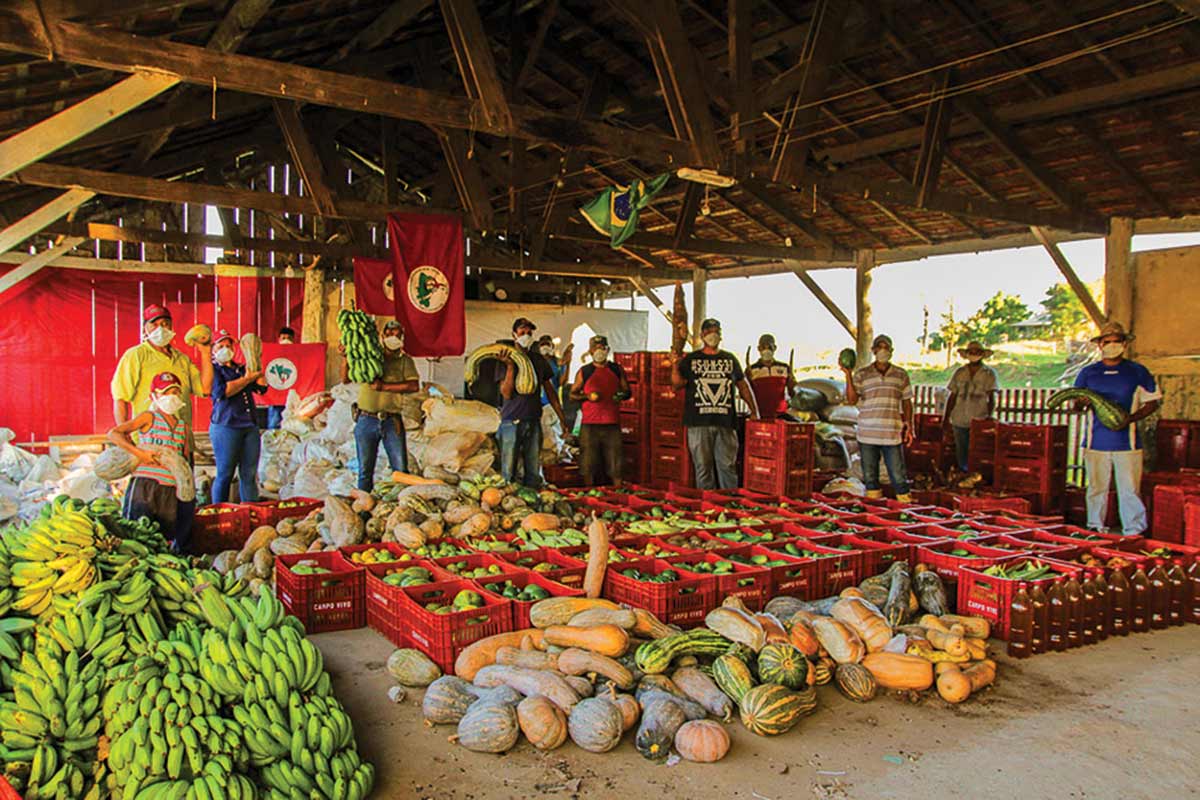
Once the trend of wearing MST gear had indeed become a trend, it inevitably began to fade. You don’t see the hat as often; it is not as fresh as it once was in edgy downtown spaces. During the height of the anti-Bolsonarista united front, some militants had joked that many of the models and DJs sporting the cap probably had parents who owned big farms that funded their lifestyles. But the movement remains far more popular than it was five or 10 years ago.
There hasn’t exactly been a rightward “vibe shift” among Brazil’s cultural elites—as the rabid support for the anti-dictatorship tearjerker I’m Still Here demonstrated—but the moment is different. While in 2021 and 2022, all hands were on deck for the desperate effort to prevent another authoritarian regime from forming, progressives here spent most of the past year watching a left-of-center government muddling through and making the best of difficult circumstances. At the end of the year, MST candidates won elections across the country.
And then Donald Trump was elected president of the United States. For the past two years, the Bolsonarista movement has made no secret that it sees the Republican as a crucial ally in its quest to retake power. At the beginning of 2025, I sat down again with Gilmar Mauro, now 58. He had just arrived in São Paulo after planting an olive tree dedicated to Palestine on his own farm.
“The United States is an empire in decline, the way we see it, and when empires go into decline, they can become more aggressive,” he told me. Trump, of course, is both the expression of this decline and the vehicle for its accompanying aggression. If he had been in power in 2022, when Bolsonaro launched his violent assault on the presidency, the coup attempt may very well have succeeded. Mauro believes that the new Trump administration will accelerate the climate catastrophe; that it seeks not only to deport migrants but to subject the United States’ remaining foreign workers to conditions approaching those of slavery; that it will attack left-wing governments in the region; and that the right-wing oligarchs who control the world’s Internet will use their platforms to manipulate elections. “Any world leaders with a few working brain cells should be quickly developing alliances to contain these dangerous forces,” he said.
On the domestic front, Mauro rattled off a series of threats to Brazil’s ecosystem. Lula’s government has dedicated only a fraction of the money that’s needed to resolve pending land-reform claims, he said. “That doesn’t mean there have not been advances. There have been.” He pointed to the battle against the extreme right as the most important world-historical task for the Lula administration. Perhaps the same goes, in recent years, for the MST. “The movement has become an organizational force. It is now an instrument that can go beyond its central mission.”
On the night of January 10, 2025, in the city of Tremembé in the interior of São Paulo State, a local man showed up at the Olga Benário MST community, which was named after the German Brazilian communist executed by the Nazis. According to witnesses, he believed that he had purchased a piece of the land and could use it as he wished. This is legally impossible—land-reform authorities had designated this area an assentamento—and representatives from the movement told him so. He left and then returned with a group of armed men. Valdir do Nascimento, 52, stepped forward to parley. The men opened fire, peppering the encampment with bullets, residents said.
“Once the shots started, they didn’t stop. It was one bullet after another. Then I saw a spark from one of the guns. After that, it was a horror scene,” said Roseli Ferreira Bernardo, whom everyone calls Binha. She told me the story outside of do Nascimento’s house. “I heard my daughter yell for me, yelling for help. But I turned and I said, ‘I can’t help. I can’t walk. I can’t walk.’”
Binha had been shot in the foot. Do Nascimento and another man, Gleison Barbosa de Carvalho, 28, were killed; four more people were wounded. The MST has always faced down the threat of violence. But this attack occurred just two hours from the largest city in South America, in a rapidly developing region. Teixeira, the minister for agrarian development, opened an investigation and said the attack was the “fruit of the seeds planted by far-right hate speech.”
The MST responded immediately. It activated a network of militants in nearby encampments, progressive allies in the cities, contacts in the media, movement lawyers, and sympathetic elected officials.
During my visit that month, the community was on high alert. Among other reinforcements, the movement had sent Thalita Carvalho, who lives in a nearby encampment and had just finished her overnight watch. Growing up, she had believed the media portrayal of the MST as a violent group that invaded and stole property. “Look at me now,” she said, “wearing boots and with a machete hanging from my belt.” Carvalho spent many years as a sex worker in the city and was often the victim of violence. She told me this must have toughened her up. “When I entered the MST, I got in trouble for drinking and fighting. I calmed down a bit when I learned I could trust everyone, and they decided to put me on the security team,” she continued, smiling. “I think I’m the only trans woman in the security corps.”
Over the years, I stayed in contact with the women in Goiás, those recruited by “Big Chicken” and the Mass Front. After months of waiting, they received good news: They could return to the land they had occupied. Things moved quickly, and land-reform authorities announced that they could permanently settle there. Unlike the case on Jocelda Ivone de Oliveira’s property, the legal situation on property used for trafficking was relatively easy to resolve, and Avelice de Sousa soon assumed a leadership position in a legal settlement. She sent me a photo of her son playing around a patch of cassava plants that were just beginning to sprout.
“We are back, and we are happy,” she said. “But we’re not done. We want to bring more people onto the land. Right now, we are digging ourselves a bigger well.”

